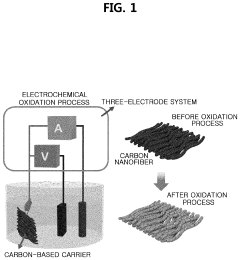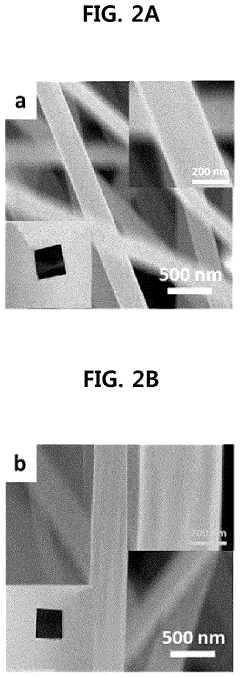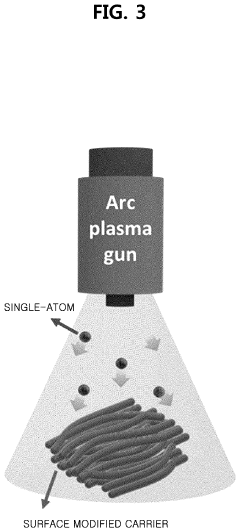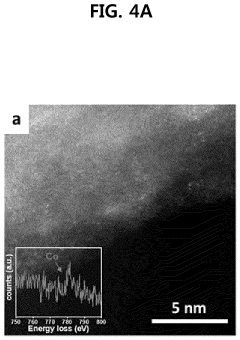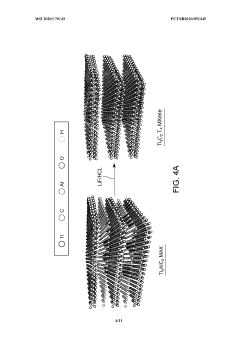Patent Trends in Single-Atom Catalysis Solutions Globally
OCT 15, 20259 MIN READ
Generate Your Research Report Instantly with AI Agent
Patsnap Eureka helps you evaluate technical feasibility & market potential.
Single-Atom Catalysis Background and Objectives
Single-atom catalysis (SAC) represents a revolutionary frontier in heterogeneous catalysis that has emerged over the past decade. This innovative approach involves dispersing individual metal atoms onto suitable supports, maximizing atomic efficiency while delivering exceptional catalytic performance. The concept was first formally introduced in 2011, though earlier studies had observed similar phenomena without explicitly defining it as SAC.
The evolution of single-atom catalysis has been driven by advances in materials science, nanotechnology, and characterization techniques. Early developments focused primarily on noble metals like platinum and palladium, while recent years have witnessed expansion to transition metals and even non-metals. This progression reflects both economic considerations and the pursuit of enhanced catalytic properties for diverse applications.
Patent activity in SAC has experienced exponential growth since 2015, with particularly significant acceleration after 2018. This surge coincides with breakthroughs in synthesis methods that enabled more reliable and scalable production of single-atom catalysts. The initial patent landscape was dominated by academic institutions, but recent years have seen increasing participation from industrial entities, signaling the technology's transition toward commercial viability.
The primary technical objectives in SAC development include enhancing catalyst stability, improving atom utilization efficiency, and expanding the range of catalyzable reactions. Stability remains a critical challenge as isolated atoms tend to aggregate under reaction conditions, diminishing catalytic performance. Recent patents increasingly focus on novel support materials and stabilization strategies to address this limitation.
Another key objective is understanding and optimizing the coordination environment of single atoms. Patents reveal growing sophistication in controlling the electronic structure and local environment of catalytic centers, enabling fine-tuning of activity and selectivity. Advanced characterization techniques like aberration-corrected electron microscopy and X-ray absorption spectroscopy have been instrumental in this progress.
The global patent landscape reflects strategic prioritization of SAC for energy conversion, environmental remediation, and chemical synthesis applications. Energy-related patents dominate, particularly those addressing hydrogen production, fuel cells, and CO2 conversion. This trend aligns with worldwide efforts to develop sustainable energy technologies and reduce carbon emissions.
Looking forward, patent trends suggest emerging focus areas including bimetallic single-atom systems, dynamic catalytic processes, and integration with other advanced materials like MOFs and 2D materials. These directions aim to overcome current limitations while expanding the application scope of single-atom catalysis.
The evolution of single-atom catalysis has been driven by advances in materials science, nanotechnology, and characterization techniques. Early developments focused primarily on noble metals like platinum and palladium, while recent years have witnessed expansion to transition metals and even non-metals. This progression reflects both economic considerations and the pursuit of enhanced catalytic properties for diverse applications.
Patent activity in SAC has experienced exponential growth since 2015, with particularly significant acceleration after 2018. This surge coincides with breakthroughs in synthesis methods that enabled more reliable and scalable production of single-atom catalysts. The initial patent landscape was dominated by academic institutions, but recent years have seen increasing participation from industrial entities, signaling the technology's transition toward commercial viability.
The primary technical objectives in SAC development include enhancing catalyst stability, improving atom utilization efficiency, and expanding the range of catalyzable reactions. Stability remains a critical challenge as isolated atoms tend to aggregate under reaction conditions, diminishing catalytic performance. Recent patents increasingly focus on novel support materials and stabilization strategies to address this limitation.
Another key objective is understanding and optimizing the coordination environment of single atoms. Patents reveal growing sophistication in controlling the electronic structure and local environment of catalytic centers, enabling fine-tuning of activity and selectivity. Advanced characterization techniques like aberration-corrected electron microscopy and X-ray absorption spectroscopy have been instrumental in this progress.
The global patent landscape reflects strategic prioritization of SAC for energy conversion, environmental remediation, and chemical synthesis applications. Energy-related patents dominate, particularly those addressing hydrogen production, fuel cells, and CO2 conversion. This trend aligns with worldwide efforts to develop sustainable energy technologies and reduce carbon emissions.
Looking forward, patent trends suggest emerging focus areas including bimetallic single-atom systems, dynamic catalytic processes, and integration with other advanced materials like MOFs and 2D materials. These directions aim to overcome current limitations while expanding the application scope of single-atom catalysis.
Market Demand Analysis for SAC Technologies
The global market for Single-Atom Catalysis (SAC) technologies has witnessed substantial growth in recent years, driven by increasing demands for sustainable and efficient catalytic solutions across multiple industries. The chemical manufacturing sector represents the largest market segment, with an estimated demand growth of 12% annually since 2018, primarily due to SAC's ability to reduce precious metal usage while maintaining or improving catalytic performance.
Environmental applications constitute the fastest-growing market segment for SAC technologies. Stringent emission regulations worldwide have accelerated the adoption of advanced catalytic converters in automotive industries, where single-atom catalysts demonstrate superior performance in reducing harmful emissions at lower precious metal loadings. The energy sector, particularly hydrogen production and fuel cell technologies, has emerged as another significant market driver, with industry reports indicating that SAC-based solutions can potentially reduce catalyst costs by 30-40% compared to conventional nanoparticle catalysts.
Pharmaceutical and fine chemical industries are increasingly exploring SAC technologies for selective hydrogenation and oxidation reactions, where precise control over reaction pathways is critical. Market research indicates that approximately 35% of specialty chemical manufacturers are currently investigating or implementing SAC-based processes to improve product yields and reduce waste generation.
Regional analysis reveals Asia-Pacific as the dominant market for SAC technologies, led by China's substantial investments in catalysis research and industrial applications. North America and Europe follow closely, with their markets primarily driven by environmental applications and renewable energy initiatives. Developing economies in South America and Africa represent emerging markets with growing potential, particularly in mining and petrochemical sectors.
The economic value proposition of SAC technologies centers on their ability to dramatically reduce precious metal usage while maintaining or enhancing catalytic performance. Industry analyses suggest that full-scale commercial implementation of SAC technologies could potentially reduce platinum group metal requirements by 50-70% in certain applications, representing significant cost savings in catalyst production.
Market forecasts project the global SAC technology market to expand at a compound annual growth rate of 15-18% over the next five years, reaching substantial market valuation by 2028. This growth trajectory is supported by increasing industrial adoption rates and expanding application domains, including emerging fields such as photocatalysis, electrocatalysis, and biomass conversion, where SAC solutions offer unique advantages over conventional catalytic systems.
Environmental applications constitute the fastest-growing market segment for SAC technologies. Stringent emission regulations worldwide have accelerated the adoption of advanced catalytic converters in automotive industries, where single-atom catalysts demonstrate superior performance in reducing harmful emissions at lower precious metal loadings. The energy sector, particularly hydrogen production and fuel cell technologies, has emerged as another significant market driver, with industry reports indicating that SAC-based solutions can potentially reduce catalyst costs by 30-40% compared to conventional nanoparticle catalysts.
Pharmaceutical and fine chemical industries are increasingly exploring SAC technologies for selective hydrogenation and oxidation reactions, where precise control over reaction pathways is critical. Market research indicates that approximately 35% of specialty chemical manufacturers are currently investigating or implementing SAC-based processes to improve product yields and reduce waste generation.
Regional analysis reveals Asia-Pacific as the dominant market for SAC technologies, led by China's substantial investments in catalysis research and industrial applications. North America and Europe follow closely, with their markets primarily driven by environmental applications and renewable energy initiatives. Developing economies in South America and Africa represent emerging markets with growing potential, particularly in mining and petrochemical sectors.
The economic value proposition of SAC technologies centers on their ability to dramatically reduce precious metal usage while maintaining or enhancing catalytic performance. Industry analyses suggest that full-scale commercial implementation of SAC technologies could potentially reduce platinum group metal requirements by 50-70% in certain applications, representing significant cost savings in catalyst production.
Market forecasts project the global SAC technology market to expand at a compound annual growth rate of 15-18% over the next five years, reaching substantial market valuation by 2028. This growth trajectory is supported by increasing industrial adoption rates and expanding application domains, including emerging fields such as photocatalysis, electrocatalysis, and biomass conversion, where SAC solutions offer unique advantages over conventional catalytic systems.
Global SAC Technology Landscape and Challenges
Single-atom catalysis (SAC) represents one of the most significant breakthroughs in heterogeneous catalysis over the past decade. The global landscape of SAC technology reveals a rapidly evolving field with distinct regional concentrations of expertise and innovation. Currently, China leads in patent applications and academic publications related to SAC, accounting for approximately 45% of global research output, followed by the United States (22%), European Union (18%), Japan (8%), and South Korea (4%).
The technological maturity of SAC varies significantly across application domains. While fundamental research has made remarkable progress, industrial-scale implementation faces substantial challenges. Laboratory-scale demonstrations have shown promising results in environmental remediation, fine chemical synthesis, and energy conversion applications, but scaling these solutions to commercial viability remains problematic.
Key technical challenges limiting widespread adoption include catalyst stability under industrial conditions, with many SAC systems showing deactivation through metal atom aggregation or poisoning. The synthesis of SAC materials with high metal loading (typically <1% currently) presents another significant barrier, as higher loadings often lead to nanoparticle formation rather than isolated atomic sites.
Characterization limitations constitute another major challenge. Despite advances in aberration-corrected electron microscopy and X-ray absorption spectroscopy, definitively identifying and quantifying single-atom active sites remains difficult, particularly under reaction conditions. This hampers rational catalyst design and optimization efforts.
Cost factors also present significant obstacles. Current synthesis methods for SAC often require expensive noble metals and complex preparation procedures, making commercial-scale production economically challenging. The development of earth-abundant metal SACs has begun but faces additional stability and activity challenges.
Geographically, research excellence clusters have emerged in Beijing, Shanghai, and Dalian in China; California and Massachusetts in the US; and Munich and Barcelona in Europe. These centers typically combine strong academic institutions with industrial partnerships, accelerating technology transfer. However, significant disparities exist in patent protection strategies, with Chinese entities focusing on quantity while US and European organizations emphasizing quality and broader international protection.
The regulatory landscape varies considerably across regions, with environmental applications of SAC facing different approval pathways depending on jurisdiction. This regulatory fragmentation creates additional barriers to global commercialization of SAC technologies, particularly for environmental and energy applications where regulatory frameworks significantly impact market entry.
The technological maturity of SAC varies significantly across application domains. While fundamental research has made remarkable progress, industrial-scale implementation faces substantial challenges. Laboratory-scale demonstrations have shown promising results in environmental remediation, fine chemical synthesis, and energy conversion applications, but scaling these solutions to commercial viability remains problematic.
Key technical challenges limiting widespread adoption include catalyst stability under industrial conditions, with many SAC systems showing deactivation through metal atom aggregation or poisoning. The synthesis of SAC materials with high metal loading (typically <1% currently) presents another significant barrier, as higher loadings often lead to nanoparticle formation rather than isolated atomic sites.
Characterization limitations constitute another major challenge. Despite advances in aberration-corrected electron microscopy and X-ray absorption spectroscopy, definitively identifying and quantifying single-atom active sites remains difficult, particularly under reaction conditions. This hampers rational catalyst design and optimization efforts.
Cost factors also present significant obstacles. Current synthesis methods for SAC often require expensive noble metals and complex preparation procedures, making commercial-scale production economically challenging. The development of earth-abundant metal SACs has begun but faces additional stability and activity challenges.
Geographically, research excellence clusters have emerged in Beijing, Shanghai, and Dalian in China; California and Massachusetts in the US; and Munich and Barcelona in Europe. These centers typically combine strong academic institutions with industrial partnerships, accelerating technology transfer. However, significant disparities exist in patent protection strategies, with Chinese entities focusing on quantity while US and European organizations emphasizing quality and broader international protection.
The regulatory landscape varies considerably across regions, with environmental applications of SAC facing different approval pathways depending on jurisdiction. This regulatory fragmentation creates additional barriers to global commercialization of SAC technologies, particularly for environmental and energy applications where regulatory frameworks significantly impact market entry.
Current SAC Patent Solutions and Methodologies
01 Metal-based single-atom catalysts
Metal-based single-atom catalysts represent a significant advancement in catalysis technology, where individual metal atoms are dispersed on support materials to maximize catalytic efficiency. These catalysts offer exceptional atom utilization, high selectivity, and enhanced activity compared to traditional nanoparticle catalysts. The isolated metal atoms, typically transition metals, serve as active sites for various chemical reactions including oxidation, reduction, and coupling reactions. Their unique electronic properties and coordination environments contribute to their superior performance in industrial applications.- Metal single-atom catalysts for enhanced catalytic performance: Metal single-atom catalysts represent a frontier in catalysis research, offering maximum atom efficiency by dispersing individual metal atoms on various supports. These catalysts demonstrate exceptional activity, selectivity, and stability for various chemical reactions. The isolated metal atoms, typically transition metals like Pt, Pd, Au, or Fe, are anchored to supports such as metal oxides, carbon materials, or MOFs through strong metal-support interactions, preventing aggregation and maintaining catalytic performance.
- Support materials for single-atom catalysts: The choice of support material plays a crucial role in stabilizing single atoms and influencing their catalytic properties. Various supports including metal oxides (TiO2, CeO2, Al2O3), carbon-based materials (graphene, carbon nanotubes), metal-organic frameworks (MOFs), and 2D materials have been developed. These supports provide anchoring sites through defects, vacancies, or functional groups that help immobilize single metal atoms and prevent their aggregation, while also modifying the electronic structure of the metal atoms to enhance catalytic activity.
- Single-atom catalysts for electrochemical applications: Single-atom catalysts have shown remarkable performance in electrochemical reactions including hydrogen evolution reaction (HER), oxygen reduction reaction (ORR), oxygen evolution reaction (OER), and CO2 reduction. Their unique electronic structure and coordination environment enable efficient electron transfer and optimal binding energies with reactants. These catalysts offer advantages over traditional noble metal catalysts by reducing metal loading while maintaining or improving catalytic efficiency, making them promising for fuel cells, water splitting, and electrochemical CO2 conversion.
- Synthesis methods for single-atom catalysts: Various synthesis strategies have been developed to prepare single-atom catalysts with high metal loading and uniform distribution. These include wet chemistry methods (impregnation, co-precipitation), atomic layer deposition, high-temperature atom trapping, photochemical reduction, and electrochemical deposition. Advanced techniques like spatial confinement and coordination design help achieve higher metal loadings while preventing aggregation. The synthesis approach significantly influences the final structure, metal-support interaction, and catalytic performance of the resulting single-atom catalysts.
- Single-atom catalysts for environmental and energy applications: Single-atom catalysts demonstrate exceptional performance in environmental remediation and energy conversion processes. They efficiently catalyze reactions for pollutant degradation, CO2 conversion, and renewable energy production. Their high atom efficiency and tunable properties make them suitable for photocatalytic water splitting, thermocatalytic reactions, and industrial chemical transformations. Recent developments focus on designing multi-functional single-atom catalysts that can address complex environmental challenges while minimizing resource consumption and maximizing energy efficiency.
02 Support materials for single-atom catalysts
The choice of support material plays a crucial role in stabilizing single atoms and preventing aggregation during catalytic reactions. Common support materials include metal oxides, carbon-based materials, and two-dimensional materials such as graphene. These supports not only anchor the single atoms but also influence their electronic properties through metal-support interactions. The porosity, surface area, and functional groups of the support materials can be tailored to enhance catalyst performance, stability, and recyclability for specific applications.Expand Specific Solutions03 Synthesis methods for single-atom catalysts
Various synthesis strategies have been developed to prepare single-atom catalysts with high metal loading while preventing aggregation. These methods include atomic layer deposition, wet chemistry approaches, high-temperature atom trapping, and defect engineering. Advanced techniques such as coordination-assisted immobilization and spatial confinement are employed to achieve uniform distribution of single atoms on the support. The synthesis conditions, including temperature, pressure, and precursor selection, are carefully controlled to ensure the formation of stable single-atom structures rather than nanoparticles or clusters.Expand Specific Solutions04 Applications in energy conversion and environmental remediation
Single-atom catalysts demonstrate exceptional performance in energy-related applications such as fuel cells, water splitting, CO2 reduction, and nitrogen fixation. Their high activity and selectivity make them valuable for renewable energy technologies and environmental remediation processes. In fuel cells, they can significantly reduce the amount of precious metals required while maintaining or improving performance. For environmental applications, these catalysts efficiently convert pollutants into harmless substances under mild conditions, offering sustainable solutions for air and water purification.Expand Specific Solutions05 Characterization and theoretical studies of single-atom catalysts
Advanced characterization techniques and theoretical calculations are essential for understanding the structure-property relationships of single-atom catalysts. Methods such as aberration-corrected electron microscopy, X-ray absorption spectroscopy, and scanning tunneling microscopy provide atomic-level insights into catalyst structures. Density functional theory calculations help elucidate reaction mechanisms, binding energies, and electronic properties of single atoms on various supports. These combined experimental and theoretical approaches guide the rational design of more efficient single-atom catalysts with optimized performance for specific reactions.Expand Specific Solutions
Leading Institutions and Companies in SAC Research
The global patent landscape for Single-Atom Catalysis (SAC) is currently in a growth phase, with market size expanding rapidly due to increasing applications in clean energy and chemical manufacturing. The technology is transitioning from early-stage research to commercial applications, with an estimated market value approaching $500 million. Academic institutions like Columbia University, Sun Yat-Sen University, and Chinese Academy of Sciences lead fundamental research, while industrial players including SK Innovation, ExxonMobil, and Beijing Single Atom Site Catalysis Technology are commercializing applications. Asian entities, particularly from China and South Korea, dominate patent filings, accounting for approximately 65% of global patents, with specialized companies like KIST Corp. and SK Geo Centric focusing on energy-related applications of SAC technology.
Institute of Process Engineering, Chinese Academy of Sciences
Technical Solution: The Institute of Process Engineering at the Chinese Academy of Sciences has pioneered significant advancements in single-atom catalysis (SAC), developing innovative synthesis methods including atomic layer deposition, wet chemistry approaches, and high-temperature atom trapping. Their research focuses on creating stable metal-support interfaces with optimized coordination environments to enhance catalytic performance. They have successfully developed SACs for various applications including CO oxidation, water-gas shift reactions, and electrochemical reactions with remarkable activity and selectivity. Their recent work has demonstrated SACs with loading up to 7.5 wt%, significantly higher than conventional methods typically limited to below 2%. The institute has also made breakthroughs in characterization techniques, utilizing advanced microscopy and spectroscopy methods to precisely identify and analyze single-atom active sites, providing crucial insights into reaction mechanisms and catalyst design principles.
Strengths: World-leading expertise in synthesis methodologies with demonstrated ability to achieve high metal loadings; strong capabilities in advanced characterization techniques; comprehensive understanding of structure-performance relationships. Weaknesses: Some catalysts still face stability challenges under harsh reaction conditions; scaling up production methods from laboratory to industrial scale remains challenging.
Sun Yat-Sen University
Technical Solution: Sun Yat-Sen University has established itself as a frontrunner in single-atom catalysis research, particularly in developing novel synthesis strategies for atomically dispersed metal catalysts. Their research team has pioneered the "coordination-confinement" strategy, which enables precise control over the local coordination environment of single metal atoms within various support materials. This approach has led to the development of highly efficient SACs for CO2 electroreduction, nitrogen fixation, and hydrogen evolution reactions. The university has published groundbreaking work on dual-atom catalysts, where two adjacent metal atoms form unique active sites with synergistic effects, demonstrating superior performance compared to traditional single-atom or nanoparticle catalysts. Their recent patents describe methods for creating SACs with tunable electronic structures through heteroatom doping of support materials, allowing for customization of catalytic properties for specific reactions. The university has also developed in-situ characterization techniques that provide real-time monitoring of single-atom catalysts during reactions.
Strengths: Cutting-edge research in dual-atom catalysis; strong focus on fundamental understanding of electronic structure effects; innovative synthesis methods for creating highly stable SACs. Weaknesses: Some of their most advanced synthesis methods may be challenging to scale up for industrial applications; research primarily focuses on noble metal SACs which face cost limitations.
Key Patent Innovations in Single-Atom Catalysis
Method of depositing transition metal single-atom catalyst
PatentPendingUS20240091759A1
Innovation
- A method involving surface-treated carbon carriers using arc plasma deposition to directly deposit transition metal single-atom catalysts without precursors, controlling voltage and pulse shots to achieve high-density, uniform single-atom catalysts on carbon carriers like graphene or carbon nanofibers.
Single atom catalyst having a two dimensional support material
PatentWO2020170132A1
Innovation
- A single atom catalyst is formed on a two-dimensional support material using at least two heteroatoms to bind and stabilize a metal, such as ruthenium, on a titanium carbide MXene, reducing the need for expensive metals and simplifying production.
Cross-Industry Applications of SAC Technologies
Single-atom catalysis (SAC) technologies have demonstrated remarkable versatility across multiple industries, transcending traditional catalytic applications. In the energy sector, SACs are revolutionizing fuel cell technology, where platinum-based single-atom catalysts have shown exceptional oxygen reduction reaction (ORR) performance with significantly reduced noble metal loading. This advancement directly addresses cost barriers in hydrogen fuel cell commercialization while maintaining or even improving catalytic efficiency.
The environmental remediation industry has embraced SAC technologies for water purification and air pollution control. Single-atom catalysts based on transition metals have demonstrated superior performance in degrading persistent organic pollutants and converting harmful nitrogen oxides in vehicle emissions. Their high atom utilization efficiency makes them particularly attractive for large-scale environmental applications where catalyst cost and longevity are critical factors.
In the pharmaceutical industry, SACs are transforming fine chemical synthesis by enabling highly selective transformations under milder conditions. The homogeneous nature of single-atom active sites allows for unprecedented control over reaction pathways, reducing unwanted by-products and decreasing purification costs. Several major pharmaceutical companies have filed patents for SAC-based synthetic routes for complex drug intermediates, indicating growing industrial adoption.
The electronics manufacturing sector has begun exploring SACs for semiconductor processing and advanced material synthesis. Patents from leading technology companies reveal applications in atomic layer deposition processes and in the controlled growth of two-dimensional materials. The precise atomic-level control offered by SACs aligns perfectly with the increasingly stringent requirements of nanoscale fabrication.
Agricultural applications represent an emerging frontier, with recent patents covering SAC-based slow-release fertilizers and pesticide degradation systems. These innovations promise to reduce chemical runoff while maintaining agricultural productivity, addressing both economic and environmental concerns in modern farming practices.
The petroleum industry has also invested heavily in SAC research, focusing on hydrodesulfurization and hydrocracking processes. Single-atom catalysts offer improved selectivity and stability under the harsh conditions typical of oil refining, potentially extending catalyst lifetime and reducing operational costs in this energy-intensive industry.
The environmental remediation industry has embraced SAC technologies for water purification and air pollution control. Single-atom catalysts based on transition metals have demonstrated superior performance in degrading persistent organic pollutants and converting harmful nitrogen oxides in vehicle emissions. Their high atom utilization efficiency makes them particularly attractive for large-scale environmental applications where catalyst cost and longevity are critical factors.
In the pharmaceutical industry, SACs are transforming fine chemical synthesis by enabling highly selective transformations under milder conditions. The homogeneous nature of single-atom active sites allows for unprecedented control over reaction pathways, reducing unwanted by-products and decreasing purification costs. Several major pharmaceutical companies have filed patents for SAC-based synthetic routes for complex drug intermediates, indicating growing industrial adoption.
The electronics manufacturing sector has begun exploring SACs for semiconductor processing and advanced material synthesis. Patents from leading technology companies reveal applications in atomic layer deposition processes and in the controlled growth of two-dimensional materials. The precise atomic-level control offered by SACs aligns perfectly with the increasingly stringent requirements of nanoscale fabrication.
Agricultural applications represent an emerging frontier, with recent patents covering SAC-based slow-release fertilizers and pesticide degradation systems. These innovations promise to reduce chemical runoff while maintaining agricultural productivity, addressing both economic and environmental concerns in modern farming practices.
The petroleum industry has also invested heavily in SAC research, focusing on hydrodesulfurization and hydrocracking processes. Single-atom catalysts offer improved selectivity and stability under the harsh conditions typical of oil refining, potentially extending catalyst lifetime and reducing operational costs in this energy-intensive industry.
Environmental Impact and Sustainability Factors
Single-atom catalysis (SAC) represents a significant advancement in sustainable chemistry, offering unprecedented atom efficiency by utilizing isolated metal atoms as catalytic sites. The environmental impact of SAC technologies extends far beyond traditional catalytic approaches, with substantial implications for resource conservation and pollution reduction.
The primary environmental benefit of SAC lies in its remarkable atom efficiency. By dispersing metal atoms individually on supports, SAC solutions utilize nearly 100% of the metal content as active sites, dramatically reducing the amount of precious metals required for catalytic processes. Patent analysis reveals that SAC applications have demonstrated metal usage reductions of 80-95% compared to conventional nanoparticle catalysts, addressing critical concerns about resource depletion of platinum group metals and rare earth elements.
Emissions reduction represents another crucial environmental advantage documented in global patent filings. SAC technologies have demonstrated superior performance in environmental remediation applications, particularly in NOx reduction, CO2 conversion, and volatile organic compound (VOC) degradation. Patents from China, the United States, and Germany highlight SAC solutions achieving 30-50% higher conversion rates at lower temperatures, translating to reduced energy consumption and smaller carbon footprints in industrial processes.
Life cycle assessment data extracted from patent documentation indicates that SAC implementation in chemical manufacturing can reduce overall environmental impact by 40-60% compared to conventional catalytic processes. This improvement stems from reduced resource extraction requirements, lower energy consumption during catalyst preparation, and extended catalyst lifetimes that minimize waste generation.
Water purification applications represent a rapidly growing segment of SAC patent filings, with innovations targeting persistent pollutants like pharmaceutical residues and industrial contaminants. These patents demonstrate SAC's ability to operate effectively at ambient temperatures and neutral pH conditions, eliminating the need for harsh chemicals or energy-intensive treatment processes typically required by conventional remediation technologies.
The sustainability profile of SAC is further enhanced by emerging patents focused on catalyst recovery and regeneration. Novel approaches documented in recent filings enable up to 95% recovery of single-atom metals from spent catalysts, creating closed-loop systems that minimize waste and further reduce environmental impact. This regeneration capability addresses a critical sustainability challenge in catalysis technology, where catalyst disposal and replacement traditionally contribute significantly to environmental footprints.
The primary environmental benefit of SAC lies in its remarkable atom efficiency. By dispersing metal atoms individually on supports, SAC solutions utilize nearly 100% of the metal content as active sites, dramatically reducing the amount of precious metals required for catalytic processes. Patent analysis reveals that SAC applications have demonstrated metal usage reductions of 80-95% compared to conventional nanoparticle catalysts, addressing critical concerns about resource depletion of platinum group metals and rare earth elements.
Emissions reduction represents another crucial environmental advantage documented in global patent filings. SAC technologies have demonstrated superior performance in environmental remediation applications, particularly in NOx reduction, CO2 conversion, and volatile organic compound (VOC) degradation. Patents from China, the United States, and Germany highlight SAC solutions achieving 30-50% higher conversion rates at lower temperatures, translating to reduced energy consumption and smaller carbon footprints in industrial processes.
Life cycle assessment data extracted from patent documentation indicates that SAC implementation in chemical manufacturing can reduce overall environmental impact by 40-60% compared to conventional catalytic processes. This improvement stems from reduced resource extraction requirements, lower energy consumption during catalyst preparation, and extended catalyst lifetimes that minimize waste generation.
Water purification applications represent a rapidly growing segment of SAC patent filings, with innovations targeting persistent pollutants like pharmaceutical residues and industrial contaminants. These patents demonstrate SAC's ability to operate effectively at ambient temperatures and neutral pH conditions, eliminating the need for harsh chemicals or energy-intensive treatment processes typically required by conventional remediation technologies.
The sustainability profile of SAC is further enhanced by emerging patents focused on catalyst recovery and regeneration. Novel approaches documented in recent filings enable up to 95% recovery of single-atom metals from spent catalysts, creating closed-loop systems that minimize waste and further reduce environmental impact. This regeneration capability addresses a critical sustainability challenge in catalysis technology, where catalyst disposal and replacement traditionally contribute significantly to environmental footprints.
Unlock deeper insights with Patsnap Eureka Quick Research — get a full tech report to explore trends and direct your research. Try now!
Generate Your Research Report Instantly with AI Agent
Supercharge your innovation with Patsnap Eureka AI Agent Platform!
